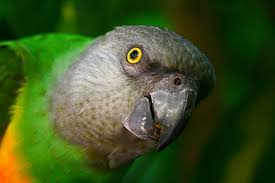Senegal Parrot

Description
The Senegal parrot (Poicephalus senegalus) is a Poicephalus parrot which is a resident breeder across a wide range of west Africa. It makes migrations within west Africa, according to the availability of the fruit, seeds and blossoms which make up its diet. It is considered a farm pest in Africa, often feeding on maize or millet. It is popular in aviculture.
Senegal parrots are about 23 centimetres (9.1 inches) long, weigh about 120 to 170 grams (4.2 to 6.0 ounces). They have a relatively large head and beak for their overall size, and feathers form a short broad tail. Adults have a charcoal grey head, grey beak, bright yellow irises, green back and throat, and yellow underparts and rump. The yellow and green areas on a Senegal parrot's front form a V-shape resembling a yellow vest worn over green. Young Juveniles have dark grey, almost black, irises, which change to light grey.
Senegal parrots are not sexually dimorphic, but there are some hypotheses which sometimes might help to determine the gender of adult birds:
- The V-shape of the vest is usually longer in females; in females the green area extends down over the chest to between the legs, whereas in males the tip of the green area ends midway down the chest.
- The female's beak and head are generally slightly smaller and narrower than the male's.
- The under-tail covert feathers (short feathers under the base of the main tail feathers) are generally mostly yellow in the male and generally mostly green in the female.
- Males are generally, but not always, larger and heavier than female birds.
Scientific Name
Poicephalus Senegalus
Country Of Origin
Africa
Size
Life Expectancy
Noise Level
Low
Talk / Trick Ability
Fair, soft spoken
Characteristics
Senegal parrots are affectionate and need enough attention to keep them from getting bored, but is independent enough to spend time on a playgym. Senegal owners find their birds to be smart, loving as well as strong-minded. Around the house, the Senegal parrot is a curious creature that closely observes the activities taking place around. Senegal parrots are known to display their intelligence in different ways, with some of them demonstrating it by figuring their way out of a cage while others express their smarts verbally. Senegal parrots have the comical, playful and animated personality of larger parrots, but without the cost, mess or noise typically associated with bigger pet parrots.
Behavior / Health Concerns
Senegals are susceptible to overgrown beaks, so provide plenty of hard wooden toys for them to chew on. They also can gain excessive amounts of weight, so their diet should consist of pellets, fresh fruits, vegetables and whole grains. Senegal parrots fiercely love their owners and show their affection by burrowing and cuddling with them. To keep the Senegal parrot from being friendly with just one person and snapping at others, be sure to socialize it with everyone in the family. Do not allow courtship behaviors and let the person who the bird does not favor as much provide its favorite treats. Stick training is also important for a Senegal parrot so it will step onto a stick or hand-held perch for every member of the family.
Expert Advice
“Male red-bellies and Senegals are sometimes confused with each other, and both have very similar personalities. Red-bellies seem to be the mellower of the two, but both need to be taught rules and guidelines to curb any territorial aggression problems that these birds are prone to.”
Bonnie Kenk, Peace Parrot Education and Adoption Center founder and executive director
“They are great birds, very intelligent and fastidious. I have yet to see one to these species feather pick. They are often stubborn little guys, but with daily attention and training routines they can remain quite enjoyable and social.”
Samuel Vaughn, DVM, Dip. ABVP – Avian Practice